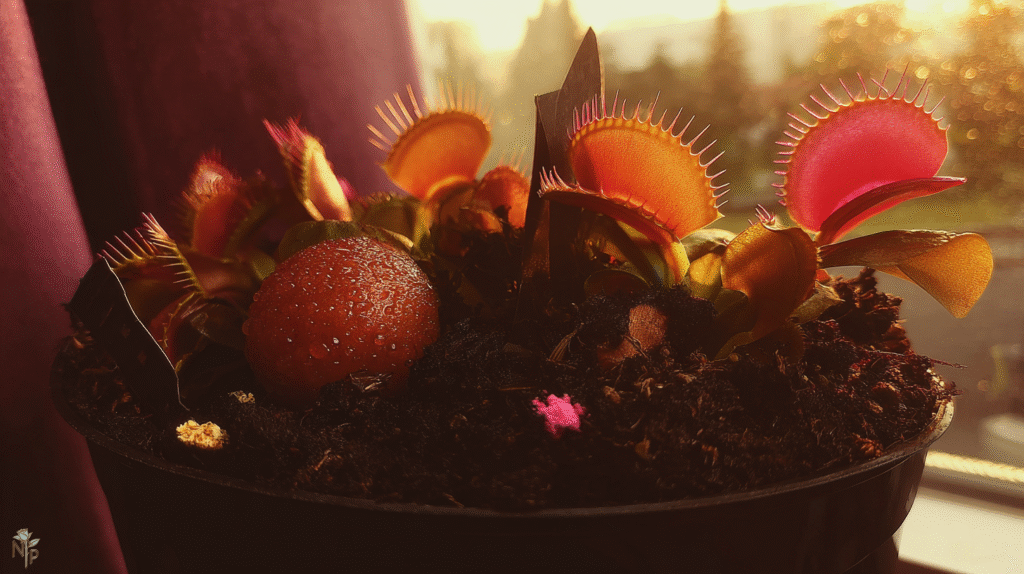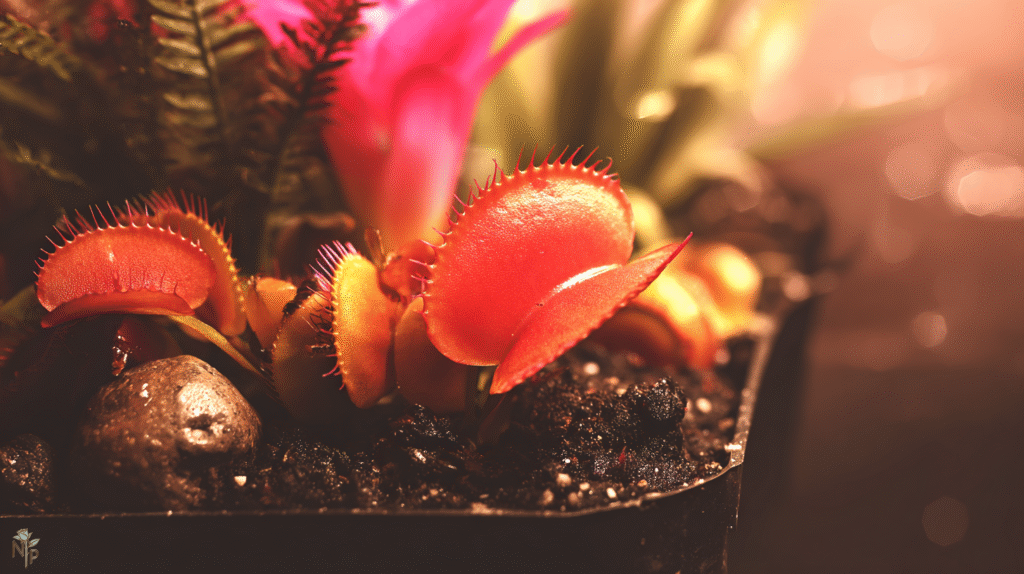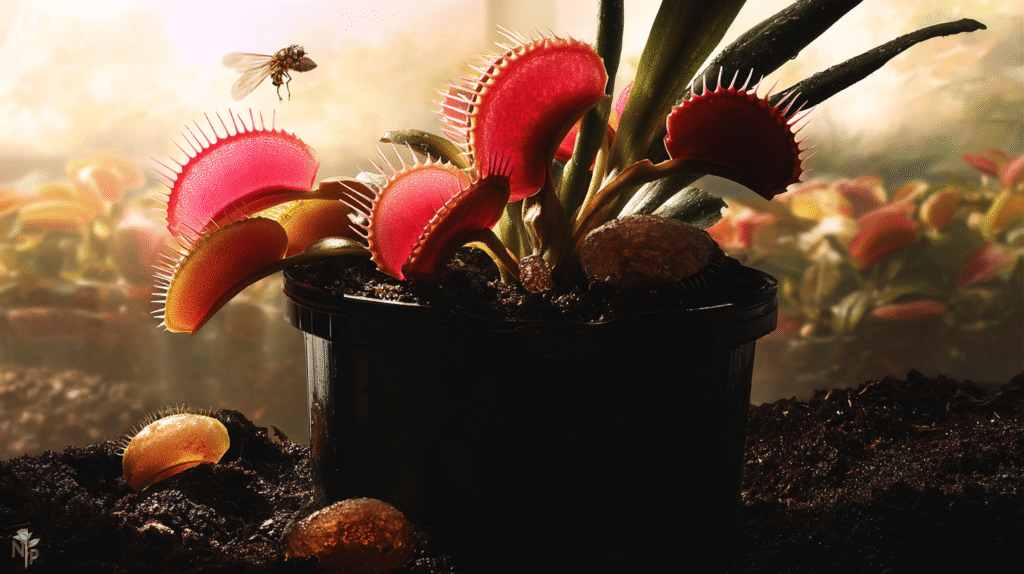My Venus flytrap journey started with a pathetic-looking plant in a plastic death cube at Lowe’s. “Save me,” it seemed to whisper from its foggy prison. Twenty bucks later, I was convinced I’d be running a bug-catching operation on my windowsill within weeks.
Reality check: That flytrap was dead within a month. So was the second one. And the third. Turns out, those care instructions on the cube — “Keep moist! Feed bugs! Easy care!” — were about as helpful as a chocolate teapot.
Four years and roughly ten dead flytraps later (I’m stubborn, okay?), I now have six thriving Venus flytraps that actually catch flies, make baby plants, and even flower. The secret? Forgetting everything the care tags say and understanding what these bog weirdos actually need. Here’s the real beginner’s guide I wish I’d had.
The Lies That Kill Most Venus Flytraps
Let’s start by destroying the myths that murdered my first several plants:
“They’re tropical!” Nope. Venus flytraps are from North Carolina. They need winter dormancy or they’ll exhaust themselves and die within two years. Keeping them warm year-round is a death sentence.
“Just keep the soil moist!” They don’t want moist. They want WET. Like, sitting-in-water wet. These are bog plants, not houseplants.
“Feed them hamburger!” Please don’t. I tried this. The trap turned black, rotted, and smelled like death. They eat bugs, not cow.
“Perfect for terrariums!” Unless you want a fungal nightmare. They need air circulation, not a humid death box.
Water: The #1 Thing That Matters
If you get nothing else right, get this right. Venus flytraps are insanely picky about water. This pickiness killed my first three plants before I understood.
Water that kills them:
- Tap water (minerals burn their roots)
- Spring water (still has minerals)
- Well water (mineral soup)
- Softened water (salt = death)
Water that works:
- Distilled water (my go-to)
- Reverse osmosis water
- Rainwater (if you’re sure it’s clean)
The rule: If the TDS (total dissolved solids) is over 50ppm, it’ll eventually kill your flytrap. I buy distilled water by the gallon at the grocery store. Yeah, it’s annoying. But it’s way cheaper than replacing dead plants.
The tray method: This changed everything for me. Sit the pot in a tray with 1/2 to 1 inch of water at all times. Never let it dry out. This felt completely wrong — aren’t we taught never to let plants sit in water? But flytraps are bog plants. They expect wet feet 24/7.

Light: More Than Your House Has
“Sunny windowsill” is a joke unless that windowsill faces south and gets 4-6 hours of direct sun. My east window? Not enough. My bright bathroom? Definitely not enough.
Signs your flytrap needs more light:
- Traps staying green instead of red inside
- Long, weak leaves reaching for light
- Few or small traps
- Generally looking sad
The solution that worked: I bought a basic LED grow light bulb ($25) and stuck it in a desk lamp. Positioned 6 inches from my plants, on for 14-16 hours daily. The transformation was incredible — compact growth, red trap interiors, vigorous plants.
Outdoor alternative: In summer, I put mine outside in full sun. They go absolutely crazy — catching bugs constantly, growing like weeds. Just remember to bring them in before winter dormancy needs.
Soil: Nutrient-Free or Death
This one’s counterintuitive. Venus flytraps grow in nutrient-poor bogs. Any fertilizer or rich soil will burn their roots and kill them. That “carnivorous plant soil” at Home Depot? Check the ingredients — some have added fertilizer.
Safe soil options:
- 50/50 peat moss and perlite (my choice)
- 50/50 peat moss and sand
- Pure long-fiber sphagnum moss
Critical tips:
- Rinse perlite before use (removes mineral dust)
- Never use beach sand (salt)
- No Miracle-Gro anything
- If it says “enriched,” run away
The Dormancy Drama Nobody Mentions
This is what killed my surviving plants after the first year. Venus flytraps MUST have winter dormancy — 3-4 months of cold rest. Without it, they exhaust themselves trying to grow year-round.
Dormancy requirements:
- Temperature: 35-50°F
- Duration: 3-4 months minimum
- Reduced light is fine
- Less water (soil damp, not soaking)
Indoor dormancy options:
Unheated room/garage: My method. Plants go in the garage by a window November through February. They look dead. That’s normal.
Refrigerator method: Remove plant, wrap in damp sphagnum, bag it, stick in fridge. Check monthly for mold. More risk but works if you have no cold space.
Skip dormancy: Your plant will likely die within 2 years. Not recommended.
Feeding: The Fun Part (But Don’t Overdo It)
Watching a Venus flytrap catch prey never gets old. But feeding isn’t as crucial as people think.
Good food:
- Small flies (perfect size)
- Spiders
- Ants
- Freeze-dried bloodworms (rehydrated)
- Any bug that fits in the trap
Bad food:
- Hamburger (will rot)
- Cheese (seriously, someone asked)
- Dead bugs that are too big
- Fertilizer pellets (death)
Feeding tips:
- One bug per month is plenty
- Outdoor plants feed themselves
- Each trap only works 3-5 times
- Don’t trigger traps for fun
- No feeding during dormancy
My indoor plants get fed maybe once a month. The outdoor ones in summer? They’re catching multiple bugs daily and growing like crazy.
Common Beginner Mistakes I Made
Overhandling: Stop touching the traps! Each trigger costs energy. I killed traps by showing everyone how they work.
Panic repotting: They hate root disturbance. Only repot in spring, and only if necessary.
Skipping dormancy: “It looks so happy, why make it cold?” Because it’ll die without rest, that’s why.
Wrong water: “One time with tap water won’t hurt.” It will. Trust me.
Death cube rehab: Those cubes create weak plants. Buy from reputable carnivorous plant nurseries instead.
Your Shopping List
After wasting money on wrong stuff, here’s what you actually need:
Essentials:
- Venus flytrap from good source ($15-20)
- Distilled water ($1/gallon)
- Peat moss and perlite ($15)
- Plastic pot with drainage ($3)
- Water tray ($2)
- Grow light if needed ($25)
Nice to have:
- TDS meter to test water ($10)
- Timer for lights ($5)
- Tweezers for feeding ($3)
Skip the terrarium kits, special “carnivorous plant food,” and death cubes.
Signs of Success vs. Trouble
Happy flytrap:
- New traps regularly
- Red color inside traps (with good light)
- Compact growth
- Catches prey successfully
- Goes dormant naturally
Unhappy flytrap:
- Black traps spreading inward
- No new growth
- Stretching for light
- Traps won’t close
- Mushy crown

Why These Demanding Plants Are Worth It
Yeah, they’re picky. Yes, you need special water. Sure, the dormancy thing is annoying. But successfully growing a Venus flytrap is incredibly rewarding. There’s something magical about a plant that moves, catches prey, and responds to stimuli.
My windowsill collection started with one death cube rescue. Now I have six different cultivars, including ‘B52’ with giant traps and ‘Dente’ with shark-tooth edges. They’ve produced dozens of babies through division. One even flowered last spring (though I cut it off — flowering weakens young plants).
Your Action Plan
- Buy from a reputable source (California Carnivores, Carnivero, etc.)
- Set up with proper soil and distilled water
- Use the tray method
- Provide maximum light (probably need grow lights indoors)
- Let them catch their own food when possible
- Plan for winter dormancy from day one
- Be patient — growth is seasonal
That first death cube taught me that Venus flytraps don’t compromise on their needs. But respect those needs, and you’ll have one of nature’s most fascinating plants thriving on your windowsill. Just remember: they’re not houseplants trying to be carnivorous — they’re bog plants putting up with your house. Treat them accordingly. 🪰\







